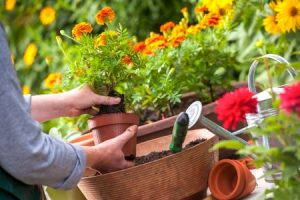
Photo credit: 123RF / Alexander Raths
Ah … spring. The grass is greener. The trees have budded and gotten leafy. The beautiful and aromatic flowers are in full bloom. This means it’s time to start planting your garden and thinking about gardening safety.
While gardening can be a source of pleasure, exercise and relaxation, it also can be the source of injuries and accidents. Therefore, before you head outside to putter around in the dirt, check out these health and gardening safety tips to make sure your planting and upkeep experience is pleasant and safe.
Don’t Ignore These 4 Gardening Safety Tips
- Wear safety equipment. Appropriate clothing, sturdy shoes, gardening gloves, goggles and a wide-brim hat are a must to reduce exposure to chemicals, insects and the sun. If you suffer from allergies and asthma symptoms, wear a protective nose and mouth mask, too.
- Apply sunscreen with a sun protective factor (SPF) 15 or higher to reduce exposure to harmful ultraviolent (UV) rays. Also, avoid gardening between 10 a.m. and 4 p.m. daylight savings time when UV rays are at their greatest.
- Drink plenty of water to decrease your risk of dehydration. Avoid caffeinated and carbonated beverages.
- Don’t wipe your face or eyes with your hands. You could expose your face and eyes to harmful substances, like chemicals, animal poo or toxins from weeds. Wash any exposed skin once you’ve come in from gardening.
Put These Gardening Safety Tips to Work as You Work
-
Pace yourself. If you haven’t been active over the winter, don’t try to tackle all your gardening work in one afternoon. Do some stretches before you start working to warm up your muscles. Know your limits when working in the heat. Take frequent rest breaks.

Photo credit: 123RF / kritchanut
- Don’t hunch over. When weeding, try to keep your back as straight as possible. Move as you weed – don’t reach too far and risk pulling a muscle.
- Lift with your legs – not your back. Bend from your knees, not your waist. Keep your back straight. Use your thigh muscles to do the lifting. Don’t lift and twist at the same time. Ask for help if you need it.
- Don’t try to carry too much. Use a wheelbarrow or wagon.
- Alternate the use of both sides of your body. When digging, alternate your leg use. Change hands from time to time while gardening.
- Kneel on both knees. Don’t kneel using just one knee. Use knee pads or a foam pad to kneel on.
- Read all instructions before using chemicals and operating equipment. When using power tools, pay attention to where cords or connections are at all times. Never leave power tools on and unattended.
- Use the right tool for the task. Don’t use a trowel when you should be using a shovel. Use ergonomic garden tools to help ease stress and strain while working.
When you use common sense and follow gardening safety rules, you can prevent accidents and injuries from occurring.
Reduce Lower Extremity Pain while Gardening
Gardening can exert a lot of stress and strain on your feet, knees, hips and lower back. Wearing properly fitted, sturdy work boots can protect your feet. However, make sure your boots provide proper arch support. Otherwise, they can contribute to foot problems like plantar fasciitis. To ensure your arches are correctly supported, insert ezWalker® Custom Fit Orthotics in your shoes or boots. These custom orthotics are specifically made to the exact specifications of each of your feet – providing you with the right support you need. Proactive use of ezWalker® Custom Orthotics can protect your feet against strains, sprains and other gardening injuries while reducing general foot fatigue.
Learn more about ezWalker® Custom Fit Orthotics by visiting the WalkEZStore.com. To order these ultra thin, ¾ length custom orthotics today, visit our online shop at this link.
Remember, gardening safety is no joke. Take care of yourself to prevent injuries and accidents from occurring.
Put a smile on your face and a spring in your step with ezWalker® Custom Fit Orthotics. Because … when your feet feel good, you feel good.®
Disclaimer: The information included in this article is for educational purposes only. It should not be used as a substitute for professional medical advice, diagnosis or treatment.

